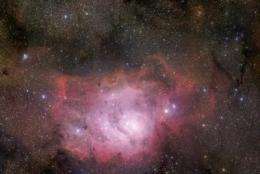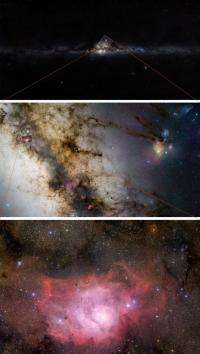The trilogy is complete -- GigaGalaxy Zoom Phase 3

The newly released image extends across a field of view of more than one and a half square degree — an area eight times larger than that of the full Moon — and was obtained with the Wide Field Imager attached to the MPG/ESO 2.2-metre telescope at the La Silla Observatory in Chile. This 67-million-pixel camera has already created several of ESO's iconic pictures.
The intriguing object depicted here — the Lagoon Nebula — is located four to five thousand light-years away towards the constellation of Sagittarius (the Archer). The nebula is a giant interstellar cloud, 100 light-years across, where stars are forming. The scattered dark patches seen all over the nebula are huge clouds of gas and dust that are collapsing under their own weight and which will soon give birth to clusters of young, glowing stars. Some of the smallest clouds are known as "globules" and the most prominent ones have been catalogued by the astronomer Edward Emerson Barnard.
The Lagoon Nebula hosts the young open stellar cluster known as NGC 6530. This is home for 50 to 100 stars and twinkles in the lower left portion of the nebula. Observations suggest that the cluster is slightly in front of the nebula itself, though still enshrouded by dust, as revealed by reddening of the starlight, an effect that occurs when small dust particles scatter light.

The name of the Lagoon Nebula derives from the wide lagoon-shaped dark lane located in the middle of the nebula that divides it into two glowing sections.
This gorgeous starscape is the last in the series of three huge images featured in the GigaGalaxy Zoom project, launched by ESO as part of the International Year of Astronomy 2009 (IYA2009). Through three giant images, the GigaGalaxy Zoom project reveals the full sky as it appears with the unaided eye from one of the darkest deserts on Earth, then zooms in on a rich region of the Milky Way using an amateur telescope, and finally uses the power of a professional telescope to reveal the details of a famous nebula. In this way, the project links the sky we can all see with the deep, "hidden" cosmos that astronomers study on a daily basis. The wonderful quality of the images is a testament to the splendour of the night sky at ESO's sites in Chile, which are the most productive astronomical observatories in the world.
"The GigaGalaxy Zoom project's dedicated website has proved very successful, drawing hundreds of thousands of visitors from all around the world," says project coordinator Henri Boffin. "With the trilogy now complete, viewers will be able to explore a magnificently detailed cosmic environment on many different scales and take a breathtaking dive into our Milky Way."
The third image of the GigaGalaxy Zoom project was taken with the Wide Field Imager (WFI) attached to the MPG/ESO 2.2-metre telescope at the ESO La Silla Observatory. In order to optimise telescope time, the images were obtained by ESO staff astronomers, who select the most favourable observations to be made at any given time, taking into account the visibility of the objects and the sky conditions. The La Silla Observatory, 600 km north of Santiago de Chile and at an altitude of 2400 metres, has been an ESO stronghold since the 1960s. Here, ESO operates several of the most productive 2-4-metre-class telescopes in the world.
More information: The GigaGalaxy Zoom web site is at: www.gigagalaxyzoom.org
This image in full resolution (TIF format, 698 MB) is available on this link.



















